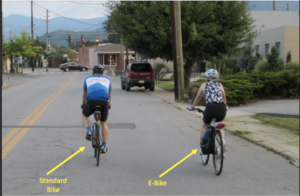In addition to the important provision that allows vehicles to cross the solid center line to pass slower moving vehicles (a big win for the BWNC and the NC bicycling community), House Bill 959: DOT Proposed Legislative Changes modifies other bicycle safety laws. These new laws will become effective today, October 1st, 2016:
- Allowing vehicles to pass slower-moving bicycles and mopeds in a no-passing zone when all safety requirements are met (and with a very good four foot distance specified- read more here)
- Legalizing the commonly-used right-hand turn signal for right turns (read here)
- Extending motorcyclists’ legal protection as vulnerable road users to bicyclists (read here)
- Updating requirements for a rear light or reflective gear on bicyclists at night (we recommend a rear light – read here for BWNC specific recommendations and here for new rear light requirement)
- Revising the definitions of autocycles and mopeds, and including a new definition for electric assisted bicycles (read here)
Viewers can read the full version of the bill here. BWNC supports the bike safety modifications in the bill and believes that implementation will add to the safety of bicyclists and motorists on public roadways. Thank you all for your comments last December 2015 on NCDOT’s report on the House Bill 232 Bike Safety Law Study report. We believe that the legislature included only the non-controversial parts of NCDOT’s recommendations because all of you spoke up and helped BWNC communicate our position and concerns. NCDOT received about 1,000 comments and the legislature received 1,000s of comments on the HB44 anti-Road Diet Bill last session, so together, we heard reference to a “bicycle movement.”
BWNC was disappointed that the final version removed the provision directing NCDOT to develop a safety education program for motorists and bicyclists. The removal likely happened because the timelines were too tight and there was no new funding. However NCDOT has committed to working with BWNC to develop a comprehensive motorist and bicyclist education program. The education program could help both motorists and bicyclists understand the rules of the road, thereby reducing conflicts.
BWNC is also thankful for NCDOT’s assistance in adding a definition of electric assisted bicycles to the bill so that e-bikes would not be classified under motorcycle laws. BWNC worked closely with NCDOT’s Division of Motor Vehicles and with House and Senate Transportation Leaders – Representatives Torbett, Iler and Shepard and with Senators Rabon and McKissick. Without the electric assisted bicycle definition and exemption from motorcycle laws, “e-bikes” would have been categorized as motorcycles and subject to all those rules and requirements. We believe that without this definition and exemption, “e-bikes” would not be able to be used on our roads, as they could not meet all the specifications of motorcycles. People for Bikes provided expertise from a national perspective and helped answer many questions about this still evolving technology.


Melvin Caldwell says
What is the minimum distance a motorist must allow when passing a cyclist in a non no passing area?
Lisa Riegel says
Two feet: The law was written years ago and was really related to a motor vehicle passing a motor vehicle – so it is only two feet. We do not have bicycle-specific passing distance other than in HB959. We are hoping that this new law that references a four foot passing distance or changing lanes to pass will be the foundation for future changes to a bicyclist-specific passing law.